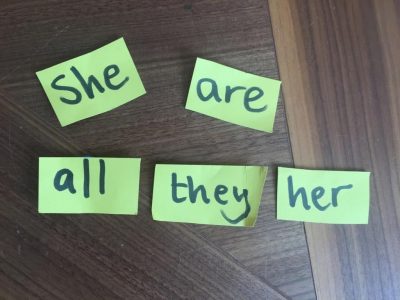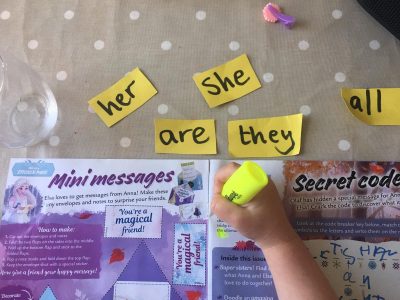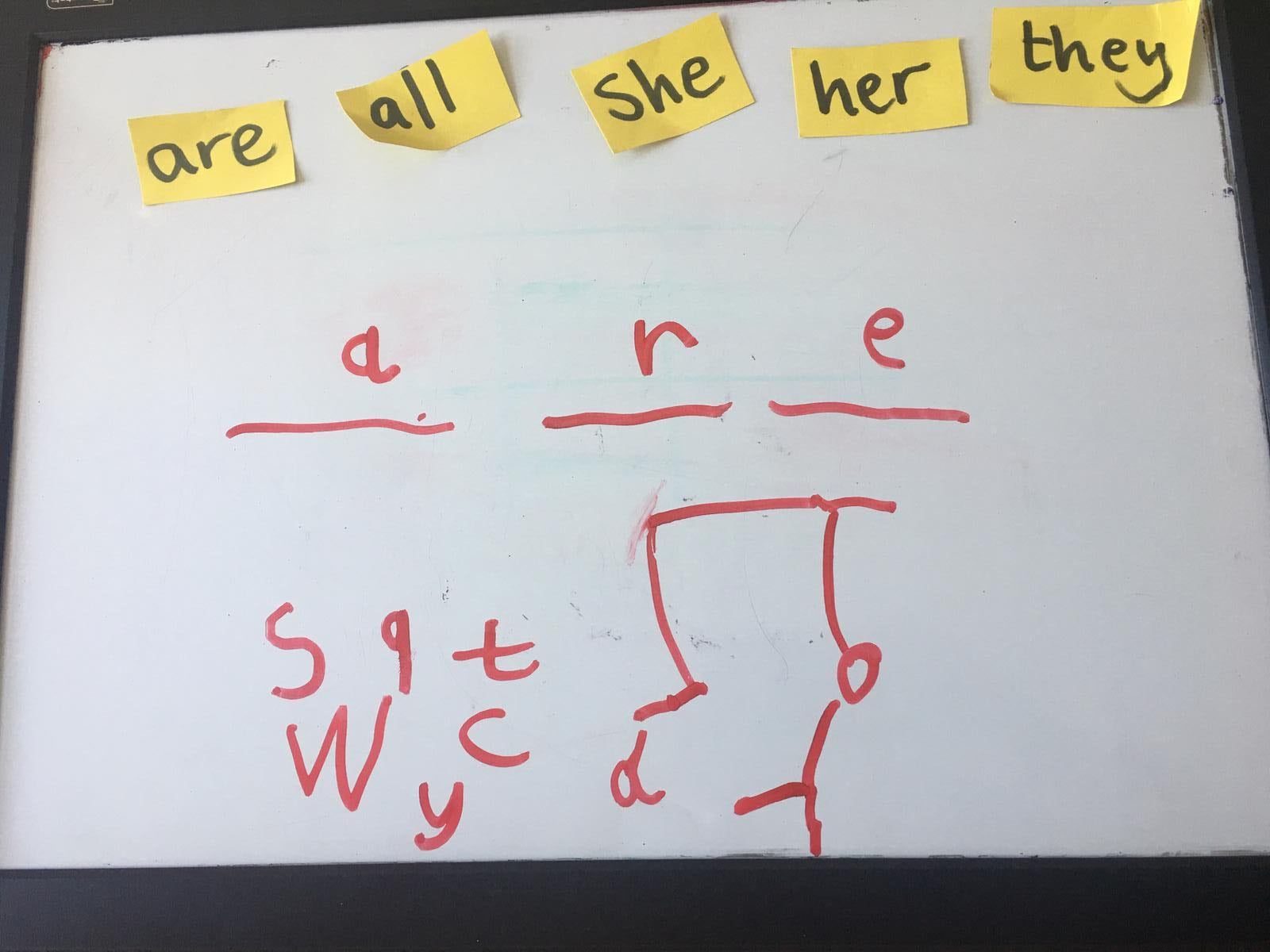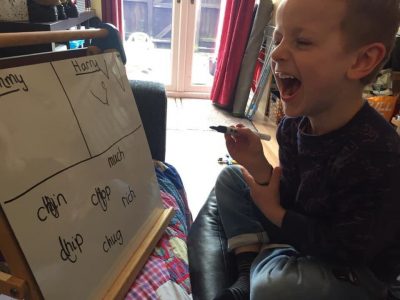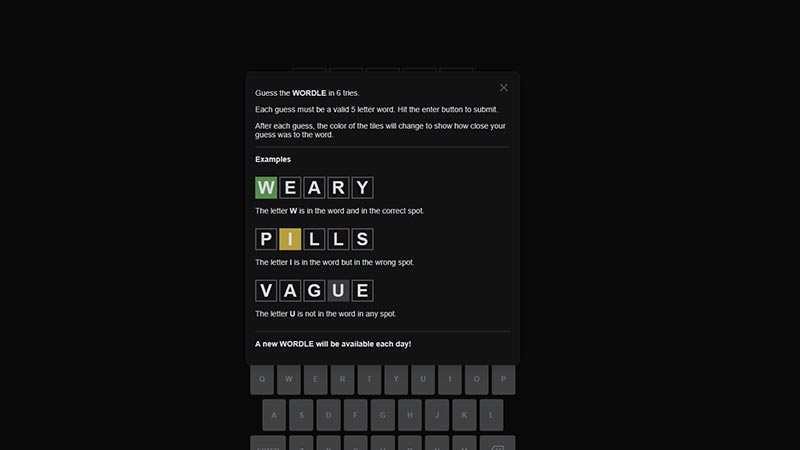Simple Tricky Words Activities for Home Learning
Tricky Words – also called irregular, high-frequency words – are hard-to-read words which often occur in early children’s books. Try sounding out these words with the standard basic sounds and you won’t get: ‘the’ and ‘was’ and ‘are’. If you want to further understand the science behind them, you can read more about their explicit, systematic teaching.
At home, my daughter and I use Phonics Hero’s tricky words games (parents can grab a free 7-day trial) but we’ve also invented lots of multi-sensory tricky word activities to practice them. In this blog post, I am going to share my top tips and favourite tricky words activities for teaching children to read these irregular words at home.
Tip 1: Make sure the adult knows them first!
If you’ve signed up for a 7-day trial and are in Australia or Hong Kong use this list; for the rest of the world, use this one.
You need to do a mini assessment: show the sheet to your child and have them read the tricky words, stop when you have a ‘bank’ of 3-6 unknown tricky words.
My daughter didn’t know five, so I wrote them out on cards and we use them to play games and reinforce through the day.
Tip 2: Pepper Tricky Words Activities Throughout the Day
There isn’t a silver bullet to learning these words but exposure and repetition is key. You need to pepper them through your day – it helps your child instantly identify them. Some ideas:
Find them in books
As you read stories, point out the tricky words then progress to pausing and having your child read them.
Look for them in junk mail or magazines
Decorate your house with them
A teacher friend of mine sticks them all around the house so she can quiz her little boy throughout the day.
Tricky (Pass)words
My daughter’s love of passwords and, in particular, the password to my iPhone (cue her unlocking it to send random texts to people!) inspired one of her new favourite tricky words activities.
Here’s how it works: Instead of numbers, we wrote tricky words into our passcode template and stuck it to the inside of the living room door. In order to open the door, she has to ‘key in’ our passcode, or series of tricky words. Three days later, she still loves it (and scolds me for opening the door without putting in the passcode!) and has learned the tricky words ‘all’ and ‘her’.
Here’s a printable Tricky Word Passcode sheet for you to insert the target words into and fill up with known words for extra practice.
Supersoaker Phonics
Bath-time is great for a no-mess reading activity!
Before running the bath, write tricky words or phonemes on the tiles with a whiteboard marker and grab a water blaster (or large syringe from any pharmacy). Little ones say each word or sound aloud as they ‘shoot’ their target!
Play Phonics Hero
Practice tricky word reading and spelling with Phonics Hero. Each level will teach between 3-6 words and there are more than 130 games over 12 levels to practice with. The reading and spelling tricky words games are indicated by these icons:
Tip 3: Use Everyday Games With an Added Tricky Word Element
We’ve started using tricky words in games such as Noughts and Crosses (AKA Tic-Tac-Toe) or Hangman.
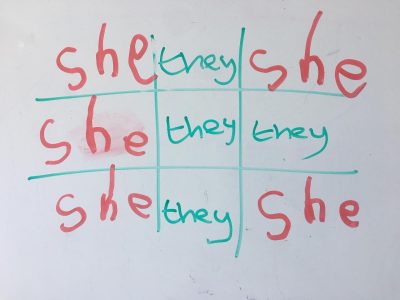
You can also double the sets of tricky words and play ‘Pairs’ or ‘Snap’.
Tip 4: Make Your Tricky Word Activities Multi-sensory!
Make some noise!
We broke out the pots and pans and my daughter started composing with the tricky words. If your ears can bear it, here’s a video:
Get your hands dirty (as you wash up)!
As you cook, clean or garden, you might use the bubbles, mud or flour to trace, land on or erase the words.
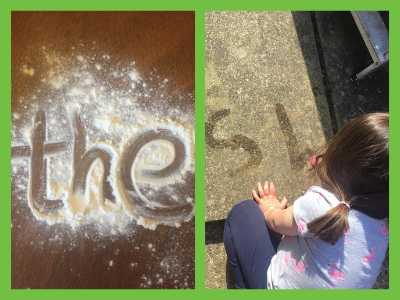
Tip 5: Play Teacher and Student
Kids love pointing out when the grown-ups have got it wrong and it’s a great test to see if they’ve learned the tricky words. As my teacher friend shows here, she and her son take turns reading the words and he awards them each a point for the correct answer (of course, mummy gets it wrong all the time – so your child gets double the practice).
Do you have a great tip or trick for teaching tricky words that you don’t see here? Share it in the comments!
Author: Katherine Wood
Katherine is the CEO and co-founder of Phonics Hero. She has worked in phonics for over 15 years, working with hundreds of schools across the globe to support them in their implementation of synthetic phonics.
Today’s Wordle answer is mentioned below so that you can complete the puzzle without any worries! On some days it can be easy, but on some, it can be super tricky too. Today, we have the answer for Wordle #663 and we will update it daily. Plus, if you are in a different time zone, you may be on yesterday’s Wordle Puzzle #662 and we’ve got the answer for that as well.
Spoilers Ahead for Wordle Today (#663) and Yesterday’s Wordle #662!
What does Today’s Wordle Answer Start With? (Hint)
- The Wordle Answer for Puzzle #663 starts with C.
- The Wordle Answer for Puzzle #663 ends with T.
Check out our guide on the best hints, tips, and starting words, best strategy to use, or try out some Wordle Solvers if you need assistance. If you want to know the answer, scroll below.
Note:- The puzzle changes daily so you simply need to head over to the official site to guess the word of the day. We will be adding the daily solutions to the list below.
Today’s Wordle Answer #663 (13 April 2023)
- CARAT
Yesterday’s Wordle Answer #662 (12 April 2023)
- BORAX
Previous NYTimes Wordle Answers
We’ve got all the previous answers from the past months right here.
How to Play Previous Wordle?
Here’s how to play past Wordle games puzzles easily. Plus, here are the best games like Wordle that are good alternatives that provide more than one puzzle a day that you may want to check out.
Here are the previous answers from 2023.
April 2023
- 663 April 13 is CARAT
- 662 April 12 is BORAX
- 661 April 11 is QUALM
- 660 April 10 is UNDER
- 659 April 9 is SNAFU
- 658 April 8 is LEDGE
- 657 April 7 is LOCUS
- 656 April 6 is LEAFY
- 655 April 5 is SMASH
- 654 April 4 is RATIO
- 653 April 3 is FLORA
- 652 April 2 is STOCK
- 651 April 1 is MARCH
March 2023
- 650 March 31 is EVERY
- 649 March 30 is BREAD
- 648 March 29 is BESET
- 647 March 28 is HURRY
- 646 March 27 is GUANO
- 645 March 26 is UNTIE
- 644 March 25 is VOTER
- 643 March 24 is GROUT
- 642 March 23 is STAID
- 641 March 22 is DUVET
- 640 March 21 is TOUGH
- 639 March 20 is GLOVE
- 638 March 19 is CREDO
- 637 March 18 is YACHT
- 636 March 17 is MEALY
- 635 March 16 is CIDER
- 634 March 15 is SWEEP
- 633 March 14 is SURLY
- 632 March 13 is BLAME
- 631 March 12 is BIRTH
- 630 March 11 is EMAIL
- 629 March 10 is REVEL
- 628 March 9 is WHERE
- 627 March 8 is REGAL
- 626 March 7 is HORSE
- 625 March 6 is PINKY
- 624 March 5 is TOXIC
- 623 March 4 is TREND
- 622 March 3 is SQUAT
- 621 March 2 is ABOVE
- 620 March 1 is MOOSE
February 2023
- 619 February 28 is POLKA
- 618 February 27 is WORSE
- 617 February 26 is SYRUP
- 616 February 25 is FIFTY
- 615 February 24 is ARBOR
- 614 February 23 is VAGUE
- 613 February 22 is RIPER
- 612 February 21 is RUDDY
- 611 February 20 is SWEAT
- 610 February 19 is KIOSK
- 609 February 18 is AVAIL
- 608 February 17 is CACHE
- 607 February 16 is MAGIC
- 606 February 15 is SALSA
- 605 February 14 is SOUND
- 604 February 13 is USAGE
- 603 February 12 is GIANT
- 602 February 11 is DEBUG
- 601 February 10 is HEADY
- 600 February 9 is STAGE
- 599 February 8 is FLAIL
- 598 February 7 is APPLE
- 597 February 6 is NINTH
- 596 February 5 is DANCE
- 595 February 4 is UNLIT
- 594 February 3 is TASTY
- 593 February 2 is SHIRK
- 592 February 1 is SCOLD
January 2023
- 591 January 31 is CROSS
- 590 January 30 is CRAVE
- 589 January 29 is FISHY
- 588 January 28 is FLIRT
- 587 January 27 is WORRY
- 586 January 26 is BEEFY
- 585 January 25 is MAIZE
- 584 January 24 is COUNT
- 583 January 23 is ELUDE
- 582 January 22 is MATEY
- 581 January 21 is BLURB
- 580 January 20 is ALTER
- 579 January 19 is MUCKY
- 578 January 18 is CHARD
- 577 January 17 is ADOPT
- 576 January 16 is FROCK
- 575 January 15 is SPIRE
- 574 January 14 is KOALA
- 573 January 13 is HUMAN
- 572 January 12 is LEAPT
- 571 January 11 is SEDAN
- 570 January 10 is GRIMY
- 569 January 9 is PIXIE
- 568 January 8 is OPERA
- 567 January 7 is LEMON
- 566 January 6 is BELIE
- 565 January 5 is SLEEK
- 564 January 4 is LAYER
- 563 January 3 is ANTIC
- 562 January 2 is SKIRT
- 561 January 1 is WHINE
Wordle FAQs Answered
How Many Tries to get the Answer?
You get 6 attempts at guessing the word of the day.
How to Get New Wordle?
Just wait until it’s 12:00 midnight in whichever time zone you’re in, and you will have a new Wordle to solve!
Wordle Rules
- If a letter from your guessed word is in the CORRECT spot of the actual word, it will show up in GREEN.
- If the letter exists in the word, but if it’s NOT in the right spot, it will be marked in YELLOW.
- And if the letter is NOT present in the actual word at all, you will see it in GREY.
If you want to know how to play Wordle, we’ve got just the guide for you. Once you nail all the tricks, guessing words can (almost) be a cakewalk!
How to Share Today’s Wordle Answer Score Result on Twitter?
Want to tell the world that you’ve figured out the answer in the fewest attempts? You can share the result ‘grid’ on Twitter without spoiling the solution for others.
- Once you have completed the daily word puzzle, a pop-up will appear with a SHARE button on it.
- Click on it and the results will get copied to the clipboard.
- Now all you have to do is head to Twitter (or any other social media site), create a post, and paste the items (Ctrl + V) that are copied to the clipboard.
- Voila! You have successfully shared the results with your followers.
That’s all about Today’s Wordle Answer, hints and previous Wordle solutions and cheats. In case this helped you out and if you are a gamer, don’t forget to explore the Wordle content on Gamer Tweak!
A screenshot of the Wordle game screen
By
- Deb Kiner | dkiner@pennlive.com
Wordle 255 is hard — not going to lie.
Wordle is a daily word game owned by the New York Times. Players get six tries to figure out the five-letter word of the day. We have some tips to help you solve today’s puzzle.
Be warned, Wordle can be addictive. Chances are, you’ve seen countless combinations of yellow and green squares popping up on social media as people share their results. But what does it all mean?
If a word guessed by the user has a letter that is in the word of the day, but not in the right order, the letter box turns yellow. If any letters are incorrect and not included in the final word, the box turns gray. But, if any of the letters guessed are in the word and are in the right position, the box turns green.
So anyway, on to some hints for today, if you need them.
- Today’s word uses two vowels — one of them twice.
- The word is not common in the United States.
- Some players on Twitter said the word is “not even completely an English word” and that the New York times was being “political.”
SPOILER ALERT
Stop scrolling if you do not want to know the answer for Tuesday, March 1, 2022.
Today is Shrove Tuesday, or as some call it, Fat Tuesday or Fastnacht Day. PennLive’s Sue Gleiter knows where to find fastnachts. What exactly is a fastnacht? Sue has that answer, too. The doughnut-type treat is a German word meaning “night before the fast.”
Sounds like the weather will cooperate for Shrove Tuesday and Ash Wednesday with highs in the 50s. There are some rain showers in the forecast.
Are you still guessing? Keep working on it and use all six of your guesses.
Here is your dead-stop. The answer follows this photo.
Volunteers at St. Cecilia’s Catholic Church in Lebanon work at the annual fastnacht sale on February 27, 2022.
Vicki Vellios Briner | Special to PennLiveVicki Vellios Briner | Special to PennLive
Today’s word is: RUPEE.
If you purchase a product or register for an account through one of the links on our site, we may receive compensation.
Here’s today’s Wordle word of the day solution.
Getty Images
It’s Friday at last, and thank goodness. This week has been weirdly long but the weekend is here at last—or very nearly here.
Let’s dive into today’s surprisingly tricky Wordle. Some of these really can be tough to solve, and this one was no exception. I got it right on my fifth guess, but for a minute there I thought it might stump me entirely.
If you’re new to the game, check out my explainer post for info on how to play and the story behind the game. I’ve also written a Wordle strategy guide which you can check out here.
The game, created by Josh Wardle as a gift for his wife during the pandemic, recently sold to The New York Times for a ‘low seven-figure’ sum. It remains free now that it’s migrated to the NYTs website, though it appears the answers have begun to diverge if you’re still on the old website vs the new thanks to some words being taken out of the game’s list of possible solutions. There are a few other minor changes at the new website, but the experience remains largely unchanged.
Today’s Wordle Answer #244
Before we get to the answer, a warning! Spoilers ahead! Going further down this post will reveal today’s answer—though before we get to that, here’s a hint:
The best thing to do when it comes to metaphorical (or real) bullets.
And the answer is . . .
Wordle 244 answer
Credit: Erik Kain
Holy Wordle, Batman! This one was tough! It took me quite a while—lots of excruciating brainstorming between guesses.
‘Quote’ wasn’t a bad first guess, since I got two vowels and eliminated one (and then could never really think of any other words that would make use of an ‘A’ or an ‘I’ once I knew where the ‘O’ and ‘E’ were supposed to go.
I also got rid of lots of common letters in my first three guesses—T, S, R, P, N. So many, I was a little lost on what was left available to me. I knew that ‘Gorge’ wouldn’t be right because of the ‘R’ but I was feeling pretty stumped and figured “Why not?”
This was the breakthrough moment, because now I had three letters in the right spots and so many others out of the running. In my mind I thought “hodgepodge” next, and very nearly went with ‘Podge’ for my fifth guess until I remembered I’d already guessed ‘Ponce’ (look up both those words for some fun British slang).
Still, I was fairly certain that it would be something with ‘odge’ at the end at this point and it wasn’t long before it came to me: Dodge! Of course! This one was close, but I dodged the bullet in the end. These words with two of the same letter are always just a smidge harder.
Etymology Notes From My Father
“Wordle is always a great challenge when the possibility of double letters bounces around. Dodge is kin to the Scottish word, dod, which means to jog. The Indo-European root, which also gives us dodder, can mean to whirl about or shake (not the chocolate kind). I guess young people dodge, my generation dodders. You can dodge a ball, metaphorically dodge a bullet, dodge the draft. If you’re a politician, you learn the art of dodging a question. Is the sky blue today? Well, one must consider the variability of concatenations of vapors in cumulus vs. cirrus manifestations . . .
“One of my favorite characters, from Dickens, is the Artful Dodger. For your young readers, he’s not a politician. He’s a thief: he charms people and slips his hand in their pockets to extract anything of value. Hmm. I guess that makes the distinction between him and politicians a bit dodgy.”
Happy Friday, Wordlers! Have a terrific weekend!
Further Reading:
- 12 Wordle alternatives you should definitely check out.
- Globle gives Wordle a fun, geographical spin.
- Check out yesterday’s Wordle #243 here.
You can follow me on Twitter and Facebook and support my work on Patreon. If you want, you can also sign up for my diabolical newsletter on Substack and subscribe to my YouTube channel.
Follow me on Twitter. Check out my website.
‘Tricky’ words are not tricky because they are hard! That’s the most important thing to understand.
Many children are put off them because they think they are difficult, as well as there being some parents that don’t want to practise them with their child because they sound intimidating.
‘Tricky’ words are called that because you can’t sound them out. That’s all there is to them!
So, in short, what is a ‘tricky’ word?
A ‘tricky’ word is one that cannot be sounded out. They are words that are non-phonetic. If you sound them out and then try to blend the sounds, you will get a word that does not sound right. They are words that must be recognized by sight.
If that sounds slightly confusing, in a moment I will go into this in greater depth to make things as clear as possible.
Also, many people have lots of other questions like how do you teach tricky words? What games can you play? When should you start learning them? What order do you learn them in?
I will answer all of these questions for you in this article, and hopefully set you up for success in teaching ‘tricky’ words to children.
What Tricky Words Are
‘Tricky’ words are non-phonetic.
Some languages have more words that are non-phonetic in them than others. Italian, for example, is almost entirely phonetic. However, English has a much greater balance between words that you can sound out and words that you can’t.
Therefore, when children try to learn English, they need to be able to use phonics to read many words, but also to memorize many words by sight as well. There are two skills that combine to help them read all the available words.
Tricky words are these words that need to be memorized, for the simple reason that if you sound them out it doesn’t sound right.
An example is the word ‘be’. If this was written phonetically, it would be written ‘bee’.
However, if children try to sound out ‘b’ then ‘e’, they would then blend the word ‘beh.’
All tricky words are like this! The are tricky because you can’t sound them out – it’s that simple!
What Is Sounding Out Words?
Early phonics works by children sounding out words. For example the word ‘dog’ can be broken into three sounds (or phonemes) ‘d-o-g.’ (If you want to find out what phonemes are in more detail, then check this out.)
They then ‘blend’ the sounds to make the word ‘dog’. Blending is basically merging the sounds together to make a word.
To find out the full lowdown on what blending in phonics is, then check out this article.
For most words in simple texts, children will be able to use this method of sounding out each word. ‘Tricky’ words are the exception. You’ve just got to sight-learn them.
What Are The Tricky Words?
The tricky words are usually taught in an order. Though this differs from country to country, and also across different reading schemes within those countries, this is roughly the order to go for:
I , no, to, the, go, into
he, she, we, me, be, you, are, her, was, all, they, my
said, have, like, so, do, some, come, were, there, little, one, when, out, what
These are the main ones to learn certainly within the first year of learning phonics (though some children will take longer than this).
High Frequency Words V Tricky Words
There are similarities between high frequency words and tricky words, but there are also differences.
First, the similarities:
- Some high frequency words are ‘tricky’ words. (However, there are many that are not)
- It is good to be able to just sight-read both
- They are taught in the order of their frequency in English. For example, the word ‘the’ is one of the most common words, and is also one of the first to be taught
Now the differences:
- The main difference between the two is that some high-frequency words can be sounded out. Examples are ‘is’, ‘it’ and ‘and’. However, it is best if children can just read them without sounding out if possible. Phonics is just a stepping stone to word recognition. The more speed and fluency children can get into their reading the better
- High-frequency words can become sight words. Sight words are words that you read without decoding. However, ‘tricky’ words are always sight words.
When To Start Teaching Them
To find maximum success with ‘tricky’ words, it is definitely worth teaching them at the right time.
I think it is important to wait until the following are true:
- Children know quite a few phonemes. It is best to let them learn lots of these as a warm-up for recognizing full words (which is quite a bit harder)
- Children should be able to sound out words, and understand how this works (Even though this is not a skill required for ‘tricky’ words, they need to know how normal phonetic words work before going on to the variation
- It is best if children are at least beginning to blend. They need to have experience and knowledge of what phonetic words are first, before you then go and muddy the waters a bit by adding in words that work differently. In an ideal world they would probably be able to blend three-letter words independently, but even if they are just starting to do this, then they have a much greater chance at reading ‘tricky’ words.
When these things have both happened, children are ready and rearing to go with learning ‘tricky’ words. But how do you introduce them?
How To Introduce Tricky Words
The classic way to introduce ‘tricky’ words is the following:
- Show the word and say it
- Put the word into a sentence. Then put it into another sentence
- See if the children can put the word into their own sentences
- Practise reading the tricky word in a simple caption
- Practise writing the tricky word
- Next day, refresh their memory by showing the word again, whilst adding another word to their repertoire
- Keep their memory fresh by showing flashcards in different fun ways for the foreseeable future
So, to teach the word ‘she’, it might go something like this:
- Show ‘she’ and say it
- Put it into a sentence, e.g. ‘She went on the bus.’
- The children make up sentences, e.g. ‘She is going to the zoo.’
- Write ‘she’
- Read ‘She is a cat.’
That’s pretty much all there is to it. Just repeat this process every time you teach a ‘tricky’ word.
Adult-Led Games To Teach Tricky Words
The big thing is to regularly practise ‘tricky’ words. The more good-quality practise you do, the more fluent the children will get.
The big problem is making this enjoyable.
‘Tricky’ words can be a bit boring! If you just show flashcards with ‘tricky’ words on day after day, many children will switch off.
Luckily, there are lots of fun games you can play to jazz this process up and keep them interested!
To start with, here are a few adult led games that you can play, to get them enjoying the process:
1.Spy Game
Spy games are always a winner. Children love the element of secrecy and surprise!
This is really simple. Show the children some flashcards of ‘tricky’ words, and they whisper the words in their best ‘spy voice’ to the person sitting next to them. Simple but great fun!
2.Round The Circle
This is probably my number one ‘tricky’ word game, and if you play no other, I would definitely play this one.
The children sit in a circle. Have a pack of ‘tricky’ word cards once again.
Pass one card to the first person in the cirle. They say the word, then pass it to the next person. That person also says the word.
Keep passing the word round the circle, and everyone says it when the hold it.
Get more cards on the go at the same time. In the end you want loads of cards going round the circle.
This game has loads of advantages, including:
– It is repetitive, and you get loads of goes of saying the words
– Even if you don’t know the words, you can listen in to the person next to you and try to pick some up
– For those that know the words, it is a good game for developing your speed and fluency
3.Speed Challenge!
Having an element of speed in games is great for competitive children.
For this game you just need a timer (probably 30 seconds is good) and a pile of flashcards.
Sit the children in a circle. The idea is to turn the timer over, and they have 30 seconds to successfully pass every single word round the circle once.
4. Different Voices!
This one is like a glorified version of showing flashcards.
You show the flashcards to the children, and they say them in different voices! For example, you could say them like a ghost! Or an alien, or a zombie, or a princess.
Say a few words at a time in once voice before switching to another. This really keeps their focus and attention.
This game is also brilliant for developing early counting, and you can read about this and many other strategies in this article.
Play-Based Games To Teach Tricky Words
As well as being lots of fun adult-led games you can do, there are also games that children can play by themselves.
Here are some excellent examples that you can have a go of:
1.Secret Hunt
Children love anything to do with detectives, and top-secret missions.
The more you can get these into what you do the better.
In this secret hunt game, all you need is some small cards with tiny tricky words written on them. Put these are around the room. Hide them under tables, at the sides of cupboards, on chair-legs – wherever you can think of.
Then give the children some magnifying glasses. They are the top-secret detectives!
They simply go round the room, try to find the mini-words, and try to read them. Hours of fun!
2. Board Game
This is really simple to set up. You make a board game that will look something like this:
You could use a snake, or a rocket, or caterpillar – anything like that which you can split into sections and put words on.
Select a few ‘tricky’ words to go on the sections. It is good to target the words you are trying to learn at that time. You could have anything from about two words, to perhaps six or seven.
This is a good game from anywhere between 2 to 6 children.
Each child playing has some kind of counter. It could be a differently colored lego piece each, for example.
They put these at one end of the board.
Now the first child rolls the dice, and goes that number of steps up the board. They try to say the ‘tricky’ word that they land on.
Then the next child goes, and so on. The winner is the child that gets to the end first.
3. Snap!
This is like the classic card game.
All you need for this is pile of lots of tricky word cards. You could have two players, or you could have a few more (maybe four might be the sensible limit for this game).
Split the tricky words between the players, and then one person puts down a card first in the middle of the table (and says the word). Then another player puts their card down, and says that one.
Just like normal snap, whenever two cards match shout ‘snap!’ and put your hand on the deck. Whoever puts their hand on them first wins all the cards. The winner of the game is the person that ends up with all the cards (or most if you have to finish in an agreed time).
If you like the sound of some of these games that I’ve listed here, then I’ve written an even more in-depth article about the 12 best ‘tricky’ word games that you can read here.
Common Mistakes (And How To Resolve Them)
There are quite a few issues that will crop up when you try to teach tricky words, and there are different things you can do to address these things.
Some of these include:
Children Try To Sound Them Out
This is the most common problem you will encounter. Children get used to the process of sounding out each when they read a sentence, and continue this process even when there is a tricky word in it.
You will often find that many children will know multiple tricky words when read in isolation, but put them into a sentence, and the child will not recognize them at all, or at least try to sound them out first .
The key to this really is practice. There is no easy way round it. Some children will just ‘spot’ the tricky words they know much quicker, and some will take longer.
The more you can develop their sight-speed fluency, the quicker they will transition to sounding out some words, and recognizing others.
They Cannot Remember Them
Some children find ‘tricky’ words much harder than phonetic words. It is, for them, a much harder skill to recognize a whole word, as opposed to just a phoneme.
The thing here is to make it multi-sensory. The more action, dance, movement, and song you can get into the teaching of ‘tricky’ words the better. This activates many more parts of the children’s brains, and gets them much more strongly engaged.
You could also thinkn about playing memory games, such as the 22 fantastic ideas that I wrote about in this article.
They Don’t Use Them In Writing
Some children will learn to be able to read the ‘tricky’ words just fine. They may even be spotting and reading them in sentences.
However, these same children may just write completely phonetically.
For example, they write ‘too’ instead of ‘to’, ‘mee’ instead of ‘me’, and ‘thai’ instead of ‘they.’
Again, this is normal, and just a process that they go through. The more practise they have of writing tricky words in isolation, the more chance they will have of recognizing when a word is ‘tricky’ when they are writing.
Top Tips For Teaching Tricky Words
- Teach them in order
- Start when children are at least beginning to blend, and know lots of phonemes
- Practise them daily
- Use fun games and bring the process to life!
- Practise and apply the skill in different contexts
Conclusion
‘Tricky’ words are not hard, I promise you! They just can’t be sounded out.
Making them fun is the big challenge, and lots of good-quality practise will get children confidently reading these words.
If you’ve found this article useful, then check out one of these…
- Ten Terrific Alliteration Activities
- Phoneme Frames – What They Are And How To Use them


